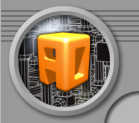 |  |  |
 |  |  |
 |  |  |
 |
 | |  | |
Hardware Performance
Our approach is to build very capable servers at reasonable prices.
Our overall design, however, is to build more servers rather than outrageously
priced, outrageously powerful servers. Having multiple servers provides us with
a level of fault tolerance hard to obtain with a single, powerful server. Also,
capacity, and thus performance and scalability, can be improved by adding more servers. The
addition of servers does not interfere with the activities of running servers.
With single, big machines, the addition of hardware capacity often means downtime.
CPU
We are currently building servers based on the Intel Core Duo,
Intel Core 2 Duo/Quad/Extreme,
Intel Xeon 3000 Sequence, and
Intel Xeon 5000 Sequence Processors.
The CPU speed and cache size is always increasing, and our
Virtual Hosting Servers,
Dedicated Servers,
Managed Servers,
and Managed Clusters
all benefit from the latest processors.
RAM
RAM must be plentiful, fast, and reliable. We use high-quality Kingston Memory Modules. Our typical
server contains between 2 GB and 16 GB of DDR2-667 (PC2-5300) or DDR2-800 (PC2-6400) RAM, but the amount and type of RAM can be varied to meet application requirements.
Our Core 2-based and Xeon-based servers benefit from Registered/ECC (Error-Correcting Code) RAM. ECC RAM is both a feature of data integrity and reliability. Data
integrity across the system is necessary for overall reliability. Able to correct one-bit errors, and able to identify multiple but errors, ECC RAM works
alongside RAID disk configurations to enhance data integrity and overall system availability.
IDE/SATA/SATA II as RAID 1 and RAID 5
For applications that primarily use CPU and RAM resources, multiple ATA/100, ATA/133, SATA, or SATA II drives in RAID 1 or 5 configurations can be more than adequate
and offer a low price to performance ratio.
SCSI RAID 1 and RAID 5
For applications that are heavily based on disk I/O, such as database servers, large-scale mail servers, or news servers, SCSI hard drives provide
much greater performance and scalability. The benefits of SCSI are threefold. The first, and most significant, advantage is the speed of available hard drives.
We use 10,000 RPM IBM/Hitachi or
15,000 RPM IBM/Hitachi hard drives, which have very low average seek times,
especially under high concurrency. We choose IBM/Hitachi SCSI drives because they run both cool and reliably. The second, and next most significant,
advantage is the increased throughput of Ultra 320 SCSI. The final advantage of SCSI is the reduced CPU consumption during intense disk activity,
keeping CPU cycles free for application use.
Redundant Power Supplies
Redundant power supplies are a possibility for all servers,
but not a necessity when the redundancy is provided through the use of multiple servers. Since
AO Industries, Inc. was founded in 1999,
only one power supply among many hundreds has failed.
Rackmount Cases
We use 2U Antec,
4U Antec,
and 4U 16-Drive Hot-Swap
rackmount cases for our virtual, dedicated, managed, and clustered servers. Rack space has become much
less expensive over the last few years, and we like every server to have an upgrade path that does
not include completely switching cases.
Resource Monitoring
Our Resource Monitoring provides graphs and triggers of hard drive use on a per-disk, per-partition,
and per-raid basis. Triggers exist to notify system administrators of failed drives so that the drives can be quickly replaced and reconstructed.
The graphs also visually show performance or load problems related to disk operations. For example, if the disk I/O rate on a drive flattens in the
graph at the same point the system load rises, that disk is a bottleneck.
Latest Hardware
For the latest hardware prices, please see our Dedicated Server Prices.
| |  | |  |
|  |
 |  |  | | このサイトに掲載の記事・写真の無断転載を禁じます。著作権はAOインダストリーに属します。 |
|

